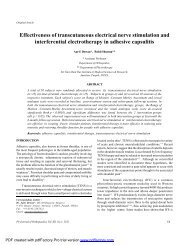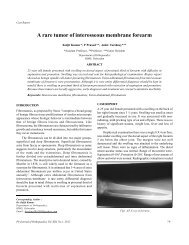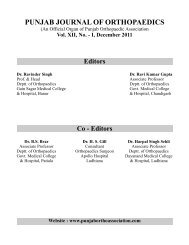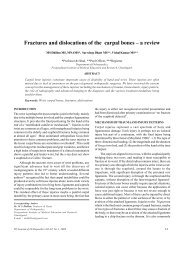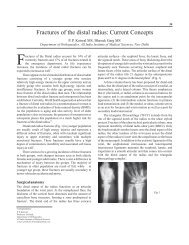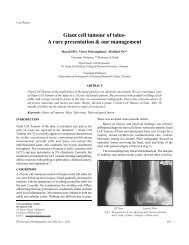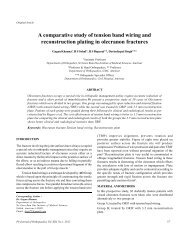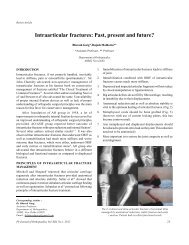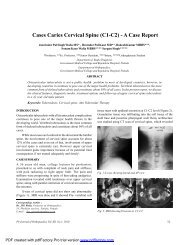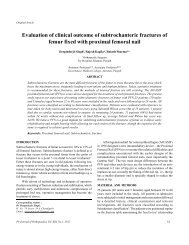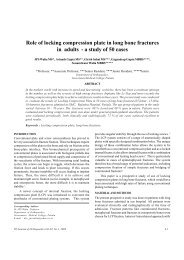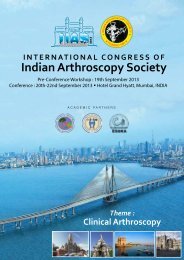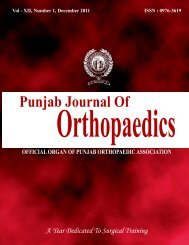Role of primary bipolar arthroplasty or total hip arthroplasty - Punjab ...
Role of primary bipolar arthroplasty or total hip arthroplasty - Punjab ...
Role of primary bipolar arthroplasty or total hip arthroplasty - Punjab ...
You also want an ePaper? Increase the reach of your titles
YUMPU automatically turns print PDFs into web optimized ePapers that Google loves.
Walia et al<br />
Reoperation rates have been rep<strong>or</strong>ted as high as 8-16%<br />
with internal fixation in intertrochanteric fractures 17,18 .<br />
Furtherm<strong>or</strong>e, repeat surgery in these patients carries with it a<br />
high incidence <strong>of</strong> medical complications and post operative<br />
dislocation <strong>of</strong> the prosthesis has also been shown to be<br />
somewhat m<strong>or</strong>e common 19 .<br />
From the above review <strong>of</strong> literature, it is evident that<br />
although the use <strong>of</strong> internal fixation has decreased the m<strong>or</strong>tality<br />
rate, the rate <strong>of</strong> complication still ranges from 4-50% 16 and<br />
walking with full weight bearing bef<strong>or</strong>e the fracture has healed<br />
is <strong>of</strong>ten impossible.<br />
There is no doubt that the general consensus would be to<br />
use internal fixation devices in stable intertrochanteric fractures<br />
in younger patients as they can tolerate immobilization and if<br />
needed, reoperation, quite well. However this is not so in elderly,<br />
debilitated patients who sustain an unstable intertrochanteric<br />
fracture.<br />
Primary <strong>arthroplasty</strong> has been advocated in elderly patients<br />
with a view to make the rehabilitation early and to lessen the<br />
incidence <strong>of</strong> complications <strong>of</strong> prolonged immobilization which<br />
are frequently encountered in the treatment with various f<strong>or</strong>ms<br />
<strong>of</strong> internal fixation devices e.g. venous thrombosis, pulmonary<br />
embolism, atelactasis and allied complications. The maj<strong>or</strong><br />
advantage <strong>of</strong> treatment with cemented endoprosthesis is the<br />
early weight bearing and the rehabilitation <strong>of</strong> these elderly<br />
patients to their pre-fractures level m<strong>or</strong>e quickly than is achieved<br />
with various fixation devices.<br />
Multiple studies 20,21,22 showed that unstable three <strong>or</strong> four<br />
part <strong>hip</strong> fractures can be treated with a standard fem<strong>or</strong>al stem<br />
prosthesis and circlage wiring <strong>of</strong> the trochanters. This technique<br />
allows safe early weight bearing on the injured <strong>hip</strong> and had a<br />
relatively low rate <strong>of</strong> complications.<br />
A maj<strong>or</strong> complication associated with <strong>arthroplasty</strong> is high<br />
rate <strong>of</strong> dislocation 23 . Associated with the dislocations was a<br />
much higher incidence <strong>of</strong> pressure s<strong>or</strong>es and pulmonary<br />
complications 24 . But use <strong>of</strong> <strong>bipolar</strong> <strong>arthroplasty</strong> instead <strong>of</strong><br />
<strong>total</strong> <strong>hip</strong> replacements can reduce this complication to an<br />
acceptable rate 25 . Haentjens et al 26 and Geiger et al 27 separately<br />
rep<strong>or</strong>ted results <strong>of</strong> <strong>arthroplasty</strong> in intertrochanteric fractures.<br />
In their studies dislocation rate in the patient group who<br />
underwent <strong>total</strong> <strong>hip</strong> <strong>arthroplasty</strong> was significantly higher<br />
(12% to 44.5%) than those who had <strong>bipolar</strong> <strong>arthroplasty</strong><br />
(0 to 3.3%).<br />
In our study, there was no significant difference between<br />
two f<strong>or</strong>ms <strong>of</strong> <strong>arthroplasty</strong> (<strong>bipolar</strong> hemi-replacement <strong>or</strong> <strong>total</strong><br />
<strong>hip</strong> replacement) in terms <strong>of</strong> hospital stay, time period required<br />
f<strong>or</strong> partial <strong>or</strong> complete weight bearing, and functional<br />
results.<br />
Though <strong>total</strong> <strong>hip</strong> <strong>arthroplasty</strong> appears to provide slightly<br />
better results regarding pain and mobility;however, its<br />
instability in addition to impaired reflexes, cognitive impairment,<br />
and weaker musculature in elderly patients shows higher<br />
dislocation rates (8%). This leads to increased hospital stay <strong>or</strong><br />
revision surgery. This complication was not seen with <strong>bipolar</strong><br />
hemi-<strong>arthroplasty</strong>.<br />
So we are <strong>of</strong> opinion that although at the outset, it may<br />
appear that the results are equally good in both the groups, in<br />
elderly patients choice should fall f<strong>or</strong> <strong>bipolar</strong> hemi-<strong>arthroplasty</strong><br />
than f<strong>or</strong> Total <strong>hip</strong> replacement.<br />
REFERENCES<br />
1. Melton LJ, 3rd. Epidemiology <strong>of</strong> <strong>hip</strong> fractures: implications <strong>of</strong> the<br />
exponential increase with age. Bone 1996; 18:121s-125s.<br />
2. Melton LJ, 3rd. Hip fractures: A w<strong>or</strong>ldwide problem today and<br />
tom<strong>or</strong>row. Bone 1993; 14 Suppl 1: s1-8.<br />
3. Alffram PA. An epidemiologic study <strong>of</strong> cervical and trochanteric<br />
fractures <strong>of</strong> the femur in an urban population with special reference<br />
to etiologic fact<strong>or</strong>s. Acta Orthop Scand 1964; 65: 9-109.<br />
4. Stern MB and goldstein TB. The use <strong>of</strong> leinbach prosthesis in<br />
intertrochantric fractures <strong>of</strong> <strong>hip</strong>. Clin Orthop 1977; 128; 325-9.<br />
5. Harris WH. Traumatic arthritis <strong>of</strong> the <strong>hip</strong> after dislocation and<br />
acetabular fractures: treatment by mold <strong>arthroplasty</strong>. An end-result<br />
study using a new method <strong>of</strong> result evaluation. J Bone Joint Surg<br />
Am. 1969 Jun; 51(4):737-55.<br />
6. Salvati EA, Wilson PD (1973) long term results <strong>of</strong> fem<strong>or</strong>al head<br />
replacement. J Bone Joint Surg Am 55a:516-524<br />
7. Parker M, Johansen A. Clinical review. Hip fracture. Bmj. 2006;<br />
333: 27-30.<br />
8. Kannus P, Parkkari J, Sievänen H, heinonen A, Vu<strong>or</strong>i I, Järvinen M.<br />
Epidemiology <strong>of</strong> <strong>hip</strong> fractures. Bone. 1996 Jan; 18(1 Suppl):<br />
57s-63s.<br />
9. Davis TR, Sher JL, H<strong>or</strong>sman A et al (1990) intertrochanteric fem<strong>or</strong>al<br />
fractures. Mechanical failure after internal fixation. J Bone Joint<br />
Surg Br 72:26-31.<br />
10. Mariani EM and Rand JA. Non-union <strong>of</strong> intertrochanteric fractures<br />
<strong>of</strong> femur following open reduction and internal fixation <strong>of</strong><br />
intertrochanteric and subtrochanteric fractures in the elderly patient.<br />
Acta Orthop Belg 1994; 60 (1): 11-3...<br />
11. Massie WK. Extra capsular fractures <strong>of</strong> the <strong>hip</strong> treated by impaction<br />
using sliding nail plate fixation. Clin Orthop 1962; 22:180.<br />
12. Holt EP JR. Hip fractures <strong>of</strong> the trochanteric region; treatment<br />
with a strong nail and early weight bearing. J Bone Joint Surg 1963;<br />
45:687.<br />
13. Dimon JH. The unstable intertrochanteric fracture. Clin Orthop<br />
1973; 92:100-107.<br />
14. Davis TR, Sher JL, H<strong>or</strong>sman A et al (1990) intertrochanteric fem<strong>or</strong>al<br />
Pb Journal <strong>of</strong> Orthopaedics Vol-XII, No.1, 2011<br />
8<br />
PDF created with pdfFact<strong>or</strong>y Pro trial version www.pdffact<strong>or</strong>y.com



